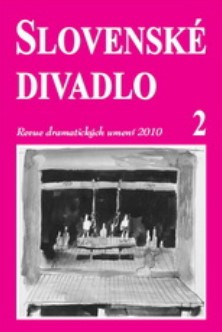Nó Na Západe – Japonský Most Cez Jedno Storočie Od W. B. Yeatsa Po Jannette Cheongovú
Noh Theatre in the West – a Japanese Bridge Over One Century From W. B. Yeats to Jannette Cheong
Author(s): Ivan R. V. RumánekSubject(s): Theatre, Dance, Performing Arts, Cultural history, Recent History (1900 till today), 19th Century, History of Art
Published by: SAV - Slovenská akadémia vied - Ústav divadelnej a filmovej vedy SAV
Keywords: cultural contacts between Japan and West; Arts; cultural exchange; Noh theatre; Ezra Pond; W. B. Yeats; Drama and music; Dance; Japanese Bridge;
Summary/Abstract: In the 19th century, the period of intensive contacts between the West and Japan was renewed. This situation led to a mutual enrichment of both cultures, especially in the field of arts, but (especially on the side of Japan) also in politics and economics. Two waves can be identified in the process of reintroduction of Japanese culture to the West until the continuous reciprocal cultural exchange as we know it after World War II. Fascination of Europe with the Japanese woodcraft (since 1862) that influenced Impressionism and later Art Nouveau can be identified as the first wave, the second wave is characterised by broader familiarity with Japanese culture and literature due to the fact that more and more Westerners mastered the secrets of the Japanese language and the first translations into the European languages appeared (the period of fin de siècle - the turn of the 20th century). Noh theatre emerged in the West as part of the second wave. As early as in 1899, the West again gained the opportunity to get familiar with the Japanese performing arts. It was during the U.S. and European tour of actor Kawakami Otojiró (1864 - 1911) who owned a private theatre Kawakami, and his wife, a former geisha Sadayakko (1871 - 1946), one of the first female actresses in modern Japan. Europe began to realize the authentic form of Noh. In London, the increase in popularity of Noh can be traced into the crucial moment, when a young American poet Ezra Pound (1885-1972,) came here in 1908 longing to get to know the Irish poet W. B. Yeats (1865-1939). Western authors appreciated how the Japanese Noh combines drama, music and dance into the monolithic whole and they considered mask an excellent means of an „alienation effect”, leading the spectators to feel separated from the events on stage and giving them an opportunity to think about the deeper meaning of events. Analysing the history of Noh in the West, we note two milestones, two points in this development which brings in mind two ends of Monet’s Pont Japonais (Japanese Bridge) in his garden in Giverny, stretching over the century of its naturalization in the West. One is the work of William Butler Yeats at the beginning of the 20th century and – a century later, Jannette Cheong’s work, the latest piece of the Western Noh. Both were written in English and premiered in London - the former at then in vogue art salon in April 1916 and the latter at London’s Southbank in December 2009.
Journal: Slovenské divadlo
- Issue Year: 58/2010
- Issue No: 02
- Page Range: 150-165
- Page Count: 16
- Language: Slovak

